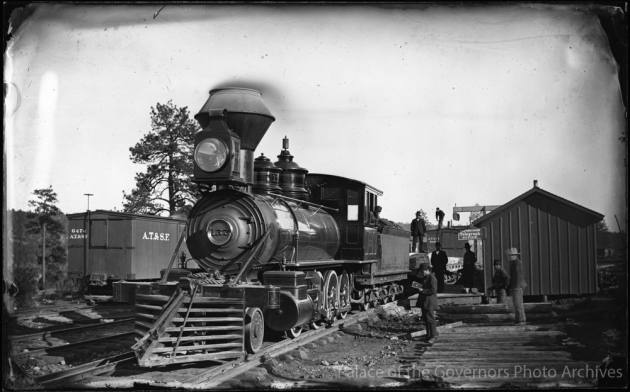History is full of misnamed entities that are like a little puzzle, where a small incident in one area directly fits into another incident. And so it is with the Atchison, Topeka and Santa Fe Railroad.
You could hardly believe that the building of one of the largest transportation companies in the world, an entity that years later would include an airline, tugboats and bus service, originally lead to a Russian “invasion” of Kansas, and the misnaming of a railroad.
The Atchison, Topeka and Santa Fe Railroad actually never went to Santa Fe. Chartered before the Civil War on February 11, 1859, the construction was all but halted during the conflict. Eventually it reached the Kansas-Colorado border and Pueblo by 1876.
Land Grant Railroads
The railroads of the west were land grant railroads granting real estate for every mile built. The railroads also created a huge need for
coal to power their steam engines. So instead of heading for Santa Fe, the Atchison, Topeka and Santa Fe Railroad found itself in a race with the Denver, Rio Grande and Western Railroad for the coal mines at Trinidad, Colorado and Raton, New Mexico. In fact, it was because the Atchison, Topeka and Santa Fe woke its track crews up an hour earlier than the Denver and Rio Grande that it was able to claim both Trinidad and Raton.
The Atchison, Topeka and Santa Fe was not so fortunate when it came to the tracks through the Royal Gorge. After gun fights and riots, Congress determined that the Gorge right of way belonged to the Rio Grande Railroad.
This left the Atchison Topeka and Santa Fe on the wrong side of the Sangre de Christo range whose 14,000 foot peaks served as a natural obstacle for getting to Santa Fe. So instead, the Atchison Topeka and Santa Fe opted to bypass Santa Fe and go on to California. The closest the railroad comes to Santa Fe is 20 miles away in Lamy, New Mexico.
Many of the mountain railroads had formed subsidiaries in logging and mining to fund their expansion, but the Atchison, Topeka and Santa Fe had Kansas land with no timber and nothing to mine, so they dispatched real estate agents to the east coast and around the world to sell Kansas property.
The Russian Collusion Connection
Enter Russia’s Czar Alexander II.
Russia has always wanted the Black Sea ports of the Crimea, fighting wars in order to win and maintain warm water ports. In 2014 Russia invaded, then took the territory from Ukraine. Russia had previously lost the Crimea and its warm water ports in the Crimean War in 1873, the same time that the construction of the Atchison, Topeka and Santa Fe was passing into Colorado.
With those land agents roaming Europe and Russia, the Atchison, Topeka and Santa Fe real estate was just too good to pass up. Mennonites from both Russia and Germany, fleeing the Russian draft, took those agents up on their offer and purchased Kansas real estate for $2.50 per acre in a land that didn’t have conscription any longer.
And all those amber waves of grain you see growing across Kansas today?
The Mennonites brought with them a crop that grew well in the arid soil of their homelands.
Wheat.
Now, the Atchison, Topeka and Santa Fe had a product to ship every year, grown on land that Americans didn’t want, and shipped on a railroad named for a town it never went to.
After a merger with Burlington Northern, the railroad is known today as the BNSF and is the largest in North America.
And the SF in BNSF? It’s there but it still doesn’t go to Santa Fe.
Bob White is a Certified Financial Planner who lives in the Pleasant Hill area. A graduate of Pembroke Hill School and the University of Kansas, he majored in Economics and minored in history. In addition to local, Kansas and Missouri history, he has an interest in its unique aspects–the events missing from the history books and timelines that paint a more complete picture.
